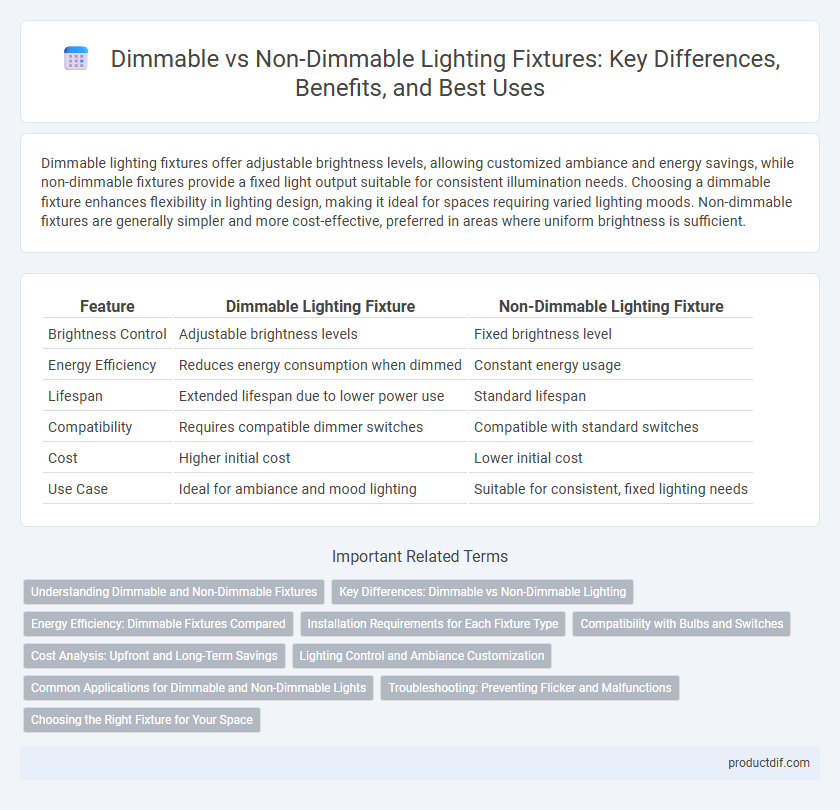Dimmable lighting fixtures offer adjustable brightness levels, allowing customized ambiance and energy savings, while non-dimmable fixtures provide a fixed light output suitable for consistent illumination needs. Choosing a dimmable fixture enhances flexibility in lighting design, making it ideal for spaces requiring varied lighting moods. Non-dimmable fixtures are generally simpler and more cost-effective, preferred in areas where uniform brightness is sufficient.
Table of Comparison
| Feature | Dimmable Lighting Fixture | Non-Dimmable Lighting Fixture |
|---|---|---|
| Brightness Control | Adjustable brightness levels | Fixed brightness level |
| Energy Efficiency | Reduces energy consumption when dimmed | Constant energy usage |
| Lifespan | Extended lifespan due to lower power use | Standard lifespan |
| Compatibility | Requires compatible dimmer switches | Compatible with standard switches |
| Cost | Higher initial cost | Lower initial cost |
| Use Case | Ideal for ambiance and mood lighting | Suitable for consistent, fixed lighting needs |
Understanding Dimmable and Non-Dimmable Fixtures
Dimmable fixtures allow adjustable light intensity, enhancing ambiance control and energy efficiency by using compatible dimmer switches and bulbs designed for varying brightness levels. Non-dimmable fixtures provide consistent lighting output without modulation options, typically featuring standard bulbs that operate at full power only. Choosing between dimmable and non-dimmable fixtures depends on lighting needs, compatibility with dimmers, and desired functionality in residential or commercial settings.
Key Differences: Dimmable vs Non-Dimmable Lighting
Dimmable lighting fixtures provide adjustable brightness levels, allowing users to customize ambiance and reduce energy consumption, whereas non-dimmable fixtures operate at a fixed brightness level with no flexibility. Compatibility with dimmer switches is a critical factor, as non-dimmable fixtures may flicker or get damaged if used with dimmers. Key differences include energy efficiency, user control, and potential installation requirements for dimmable versus non-dimmable lighting systems.
Energy Efficiency: Dimmable Fixtures Compared
Dimmable lighting fixtures offer superior energy efficiency compared to non-dimmable fixtures by allowing users to adjust brightness levels, reducing electricity consumption during lower light settings. Energy savings can reach up to 50% when fixtures are dimmed to half their maximum output, significantly lowering utility costs and extending bulb lifespan. Non-dimmable fixtures operate at full power continuously, resulting in higher energy use and less control over lighting intensity.
Installation Requirements for Each Fixture Type
Dimmable lighting fixtures require compatible dimmer switches and wiring that supports dimming controls, often involving low-voltage or 0-10V systems for smooth brightness adjustment. Non-dimmable fixtures have simpler installation needs, typically connecting directly to a standard on/off switch without specialized dimming controls. Ensuring correct compatibility between dimmers and dimmable fixtures is crucial to prevent flickering, buzzing, or damage.
Compatibility with Bulbs and Switches
Dimmable fixtures require compatible dimmable bulbs and dimmer switches designed to support variable voltage control, ensuring smooth brightness adjustment and preventing flickering or damage. Non-dimmable fixtures use standard bulbs and switches with fixed voltage, offering straightforward operation but no brightness variability. Choosing the right fixture type ensures optimal performance, bulb longevity, and energy efficiency in lighting systems.
Cost Analysis: Upfront and Long-Term Savings
Dimmable lighting fixtures generally have a higher upfront cost due to more complex electronics and compatible dimmer switches, but they offer significant long-term savings by reducing energy consumption and extending bulb lifespan. Non-dimmable fixtures are typically less expensive initially but lack energy-saving flexibility, potentially leading to higher electricity bills and more frequent bulb replacements over time. Evaluating total cost of ownership highlights that dimmable fixtures can be more economical in spaces where adjustable lighting and energy efficiency are priorities.
Lighting Control and Ambiance Customization
Dimmable lighting fixtures provide precise control over brightness levels, enabling tailored ambiance and energy savings by adjusting light intensity to suit different moods and activities. Non-dimmable fixtures operate at a fixed brightness, limiting flexibility in lighting control and ambiance customization. Choosing dimmable fixtures enhances the ability to create dynamic environments and optimize comfort in residential and commercial spaces.
Common Applications for Dimmable and Non-Dimmable Lights
Dimmable lighting fixtures are commonly used in residential settings, restaurants, and theaters where adjustable ambiance and mood control are essential. Non-dimmable fixtures are often installed in commercial offices, warehouses, and outdoor security areas where consistent, full brightness is required. Choosing between dimmable and non-dimmable lights depends on the desired lighting functionality and energy efficiency needs for the specific environment.
Troubleshooting: Preventing Flicker and Malfunctions
Flickering in dimmable lighting fixtures often arises from incompatible dimmer switches or poor wiring connections, requiring the use of dimmers specifically designed for the fixture's wattage and type. Non-dimmable fixtures typically do not flicker, but if malfunctions occur, checking for loose wiring or faulty bulbs is essential to prevent flicker and maintain stable operation. Ensuring compatibility and proper installation between fixtures and control devices is critical to avoid common issues like flickering and intermittent light output.
Choosing the Right Fixture for Your Space
Dimmable lighting fixtures offer precise control over brightness, enhancing ambiance and energy efficiency in residential and commercial spaces. Non-dimmable fixtures provide consistent illumination ideal for areas requiring steady, reliable lighting such as task-oriented or safety-critical environments. Selecting between dimmable and non-dimmable fixtures depends on the specific functional needs and desired atmosphere of your space.
Dimmable fixture vs Non-dimmable fixture Infographic

 productdif.com
productdif.com